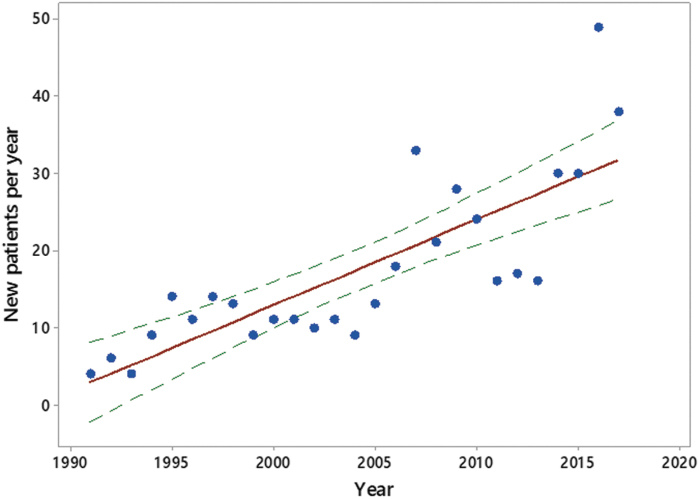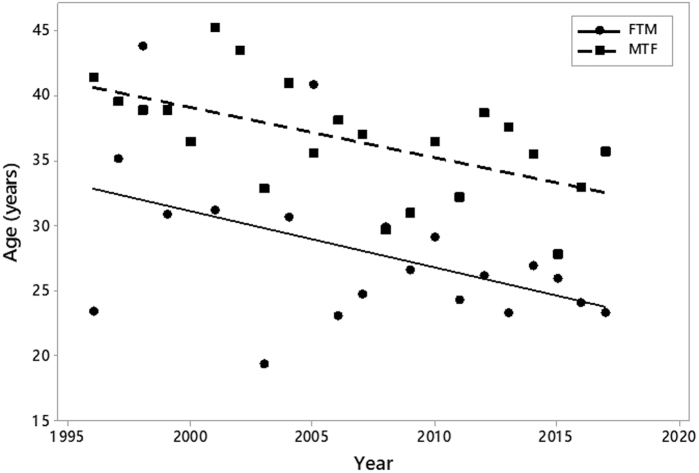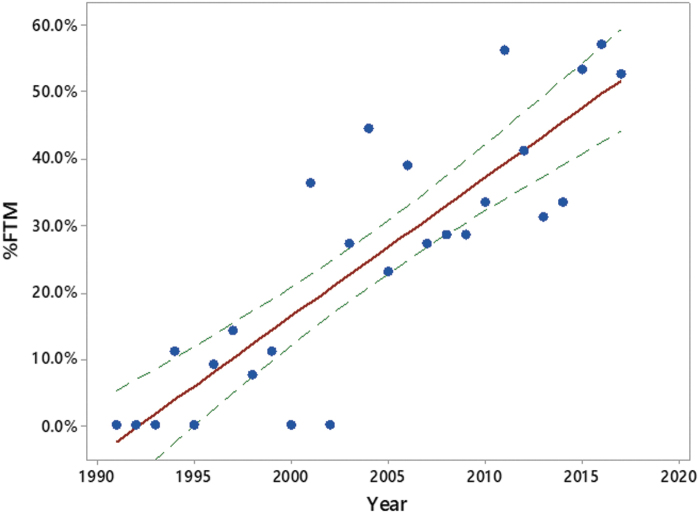Abstract
Introduction: The number of individuals seeking sex hormone therapy for gender dysphoria has been increasing. The prevalence gender dysphoria has recently been estimated as high as 390 to 460 per 100,000 with a consistently greater prevalence of trans women (MTF) than trans men (FTM). We report here the changing demographics encountered in our experience over the past 2 decades.
Methods: We collected data on individuals receiving hormonal therapy in the transgender clinic at Albany Medical Center in upstate New York from 1990 to 2017. We analyzed temporal changes in the number, age, and gender identity of transgender individuals.
Results: Through June 2017, a total of 421 transgender individuals were seen who initiated hormonal therapy after 1990. Over the past 25 years, there has been a significant increase in the number of individuals seen. The mean age at initiation has remained higher in MTF than in FTM but has decreased steadily in both groups with the overall average dropping <30 years since 2015 (27.5±10.6). Since 1990, there has been a steady increase in the percentage of FTM such that it is now equivalent to MTF.
Conclusion: Consistent with many reports, we are seeing an increasing number of gender dysphoric individuals seeking hormonal therapy. The age at initiation has been dropping over the past 25 years, and we have seen a steady increase in the number of FTM such that the incidence now equals that of MTF. Possible reasons for these changes are discussed.
Keywords: adolescence, age, epidemiology, transgender
Introduction
Gender dysphoria has generally been thought to be uncommon. A recent meta-analysis of individuals attending clinical services reported prevalence rates <4.6 individuals per 100,000 (6.8 for trans women (MTF) and 2.6 for trans men (FTM) per 100,000, respectively).1 However, some recent estimates based upon population surveys have been considerably higher, with overall rates as high as 580 individuals per 100,000 identifying as transgender in the United States.2,3 The number of individuals seeking hormonal therapy and gender-affirming surgery for gender dysphoria has been increasing in the United States and elsewhere.2,4–7 Despite these noted changes, there is limited data concerning any temporal changes in this emerging population. We report here our observations on the changing demographics over a period of >25 years in our transgender population.
Methods
Albany Medical Center (AMC) is an academic tertiary care medical center covering a population of >2.5 million in upstate New York. Since 2003, we have prospectively collected demographic data on individuals receiving hormonal therapy in the transgender clinic at AMC. Data before that were collected retrospectively back to 1990. Our transgender clinic is part of an endocrinology subspecialty clinic and sees patients referred for initiation or continuation of sex hormone therapy. All individuals treated have been diagnosed by mental health professionals with gender dysphoria (or “Gender Identity Disorder” before Diagnostic and Statistical Manual of Mental Disorders-V). Some adolescents received pubertal blockade before initiating sex hormone therapy: for purposes of analysis, this was considered as the initiation of therapy. Individuals not receiving hormonal therapy were not included in the analysis.
Changes over time were analyzed by linear regression. Statistics were run using Minitab 18 (College Station, PA). The age at initiation of medical therapy was analyzed by multiple regression with effects of year of study, group (MTF or FTM), and their interaction. A significant interaction term would suggest that the effect of year of study was different in the two groups. Nonsignificant interaction terms were dropped from the model for data presentation. Significance was accepted at the p<0.05 level.
Results
Through June 2017, a total of 421 transgender individuals were seen who initiated hormonal therapy after 1990. Feminizing therapy with estrogen was begun by 283 transgender individuals (67%) and 138 transgender individuals (33%) received testosterone for masculinization. Six adolescents received GnRH therapy before sex hormone therapy. Average follow-up time was 6.03 years and ranged up to 24.7 years. We are aware of just one individual in the cohort who has reversed gender back to that assigned at birth. Since our transgender clinic functions as a referral center for sex hormone therapy, <20 individuals were seen who did not receive therapy.
Over the past 25 years, there has been a significant increase in the number of new patients seen in our clinic who are receiving sex hormone therapy. There has been a rise of 11.1 (standard error [SE]: 1.6) individuals per decade over the period 1991 to 2016 (p<0.001; r-squared=64.4%; Fig. 1). The mean age at initiation of therapy for the entire cohort was 32.4±12.7 (range 13.0 to 60.4) years but was higher for MTF than for FTM (35.5±13.2 and 26.2±8.6 respectively: p<0.01). There has been a significant change over time in the age at initiation of hormonal therapy (Fig. 2), with a drop of 4.3 (SE=1.2) years of age per decade for both MTF and FTM. MTF were older than FTM by 8.0 (SE=1.6) years (p<0.01). There was no significant interaction effect (p=0.40), suggesting the decline in age over time for both groups was similar. In just the past few years (2015 through June 2017), 73 individuals initiated cross-gender therapy and the average age has dropped to 27.5±10.6 years (31.9±12.5 for MTF, 24.3±7.8 for FTM). Fifteen individuals began hormonal therapy under our direction before age 18 years: 10 of these started therapy after 2014.
FIG. 1.
Number of patients seeking to initiate hormonal therapy by year.
FIG. 2.
Age at initiation of hormone therapy for trans men and trans women by year.
Since 1990 there has been a steady increase in the percentage of patients seeking hormonal therapy for transition to male gender, such that over the most recent years, it has equaled the number seeking transition to female gender. The percentage of individuals seeking transition to male gender was frequently 0% in the years up to 2002, but increased thereafter with the average increase in percentage seeking transition to male gender rising by 21% (SE: 2) per decade (p<0.001; r-squared=74.4%; Fig. 3).
FIG. 3.
Percentage of trans men seeking to initiate hormonal therapy by year.
Discussion
The number of individuals receiving sex hormone therapy for gender dysphoria has been increasing. We report here significant demographic changes that have been seen over the past 25 years.
We have observed that the age at initiation of sex hormone therapy has decreased over time. Although our finding of older age at initiation of hormonal therapy in MTF compared with FTM is consistent with previous reports,8 we saw a similar decrease in age over the past decades in both groups such that the overall average age at initiation of therapy of 37 years before 2006 has dropped <30 years. Although an increase in the number of children and adolescents with gender dysphoria has been noted in a number of studies,9–11 this decrease in age at initiation of sex hormone therapy in adults has been reported only rarely.5 The decrease in age in adults in our cohort is not due to a recent influx of adolescents: we first noted this temporal change in 2012.4
Studies have consistently reported a greater prevalence of MTF than FTM.12 A recent meta-review found a ratio of ∼2:1.1 We had previously noted an increase over the past two decades in the percentage of FTM initiating sex hormone therapy compared with MTF.4 We have now reached the point wherein we are seeing at least as many FTM initiating sex hormone therapy as MTF. Studies reporting equal or higher rates of FTM than MTF are rare and have been felt to reflect only specific populations.13 However, data are emerging that this may no longer be the case. Reports from New Zealand5 and Serbia14 have found increasing percentages of FTM seeking hormonal therapy. In the United States, a recent review of Kaiser Permanente health plans in Georgia and California found the ratio of MTF to FTM dropped from 1.7:1 to 1:1 between 2006 and 2014.15 The Amsterdam Cohort of Gender Dysphoria Study recently updated their experience since 1972. An earlier report from this group cited a MTF to FTM ratio of 2.6 to 1992.16 Their updated ratio through 2015 is now 1.3 and they note that more FTM than MTF presented in the final year reported (2015).8 They further note that this change was driven by an increase in adolescent transgender boys. This recent increase and prevalence of transgender boys were recently reported separately9,11,17 and is mirrored in our results, in which 12 of 15 adolescents starting therapy under our care since 2014 are FTM. A follow-up analysis from the Dutch investigators surmises that the recent increase in adolescent referrals simply reflects that seeking help for gender dysphoria has become more common, rather than adolescents being referred with lower intensities of dysphoria or more psychological difficulties.18
There are many possible explanations for these temporal changes. There has been increased acceptance and destigmatization of the transgender community in many societies possibly due to the Internet and social media.4,9,19 Decreases in barriers to care have allowed greater numbers to seek therapy. We speculate that the most important factor in our findings is the changing social attitude toward lesbian, gay, bisexual, transgender, and queer/questioning (LGBTQ) individuals in our area. Same sex marriage became legal in New York in 2011, followed in 2015 by an insurance coverage mandate for transgender services (including hormonal therapy).
The rising percentage of FTM seeking therapy may indicate that the frequency of severe gender dysphoria is not very different between genders. If so, it raises the question of why greater number of FTM did not seek therapy previously. One possibility is that a relatively lower degree of social stigmatization of females adopting cross-gender behaviors (compared with males) allowed some alleviation of gender dysphoria in transgender males.9 With a decrease in barriers to care, this difference could become less important as transgender males with partial cross-gender social roles seek more complete resolution of their dysphoria.
In summary, comparable with many other centers, we have seen an increasing number of transgender individuals initiating hormonal therapy. Over the past 25 years, we have seen the age at initiation of sex hormone therapy in both FTM and MTF drop steadily. Contrary to the prevailing view,1 however, we have also seen a significant increase in the percentage of FTM compared with MTF, such that the incidence rates appear to be equalizing. We hypothesize that increasing social acceptance of the LGBTQ community and decrease in barriers to care are a significant factor in these temporal changes.
Ethics
All procedures performed in studies involving human participants were in accordance with the ethical standards of the institutional and/or national research committee and with the 1964 Helsinki declaration and its later amendments or comparable ethical standards.
Abbreviations Used
- AMC
Albany Medical Center
- SE
standard error
- LGBTQ
lesbian, gay, bisexual, transgender, and queer/questioning
Author Disclosure Statement
No competing financial interests exist.
Funding Information
No funds were provided for this project.
Cite this article as: Leinung MC, Joseph J (2020) Changing demographics in transgender individuals seeking hormonal therapy: are trans women more common than trans men? Transgender Health 5:4, 241–245, DOI: 10.1089/trgh.2019.0070.
References
- 1. Arcelus J, Bouman WP, Van Den Noortgate W, et al. Systematic review and meta-analysis of prevalence studies in transsexualism. Eur Psychiatry. 2015;30:807–815 [DOI] [PubMed] [Google Scholar]
- 2. Flores ARHJ, Gates GJ, Brown TN. How many adults identify as transgender in the United States? Los Angeles, CA: The Williams Institute, 2016 [Google Scholar]
- 3. Meerwijk EL, Sevelius JM. Transgender population size in the United States: a meta-regression of population-based probability samples. Am J Public Health. 2017;107:e1–e8 [DOI] [PMC free article] [PubMed] [Google Scholar]
- 4. Leinung MC, Urizar MF, Patel N, Sood SC. Endocrine treatment of transsexual persons: extensive personal experience. Endocr Pract. 2013;19:644–650 [DOI] [PubMed] [Google Scholar]
- 5. Delahunt JW, Denison HJ, Sim DA, et al. Increasing rates of people identifying as transgender presenting to Endocrine Services in the Wellington region. N Z Med J. 2018;131:33–42 [PubMed] [Google Scholar]
- 6. Canner JK, Harfouch O, Kodadek LM, et al. Temporal trends in gender-affirming surgery among transgender patients in the United States. JAMA Surg. 2018;153:609–616 [DOI] [PMC free article] [PubMed] [Google Scholar]
- 7. Goodman M, Adams N, Corneil T, et al. Size and distribution of transgender and gender nonconforming populations: a narrative review. Endocrinol Metab Clin North Am. 2019;48:303–321 [DOI] [PubMed] [Google Scholar]
- 8. Wiepjes CM, Nota NM, de Blok CJM, et al. The Amsterdam Cohort of Gender Dysphoria Study (1972–2015): trends in prevalence, treatment, and regrets. J Sex Med. 2018;15:582–590 [DOI] [PubMed] [Google Scholar]
- 9. Aitken M, Steensma TD, Blanchard R, et al. Evidence for an altered sex ratio in clinic-referred adolescents with gender dysphoria. J Sex Med. 2015;12:756–763 [DOI] [PubMed] [Google Scholar]
- 10. Olson-Kennedy J, Cohen-Kettenis PT, Kreukels BP, et al. Research priorities for gender nonconforming/transgender youth: gender identity development and biopsychosocial outcomes. Curr Opin Endocrinol Diabetes Obes. 2016;23:172–179 [DOI] [PMC free article] [PubMed] [Google Scholar]
- 11. Olson J, Schrager SM, Belzer M, et al. Baseline physiologic and psychosocial characteristics of transgender youth seeking care for gender dysphoria. J Adolesc Health. 2015;57:374–380 [DOI] [PMC free article] [PubMed] [Google Scholar]
- 12. Zucker KJ. Epidemiology of gender dysphoria and transgender identity. Sex Health. 2017;14:404–411 [DOI] [PubMed] [Google Scholar]
- 13. Baba T, Endo T, Ikeda K, et al. Distinctive features of female-to-male transsexualism and prevalence of gender identity disorder in Japan. J Sex Med. 2011;8:1686–1693 [DOI] [PubMed] [Google Scholar]
- 14. Vujovic S, Popovic S, Sbutega-Milosevic G, et al. Transsexualism in Serbia: a twenty-year follow-up study. J Sex Med. 2009;6:1018–1023 [DOI] [PubMed] [Google Scholar]
- 15. Quinn VP, Nash R, Hunkeler E, et al. Cohort profile: study of Transition, Outcomes and Gender (STRONG) to assess health status of transgender people. BMJ Open. 2017;7:e018121. [DOI] [PMC free article] [PubMed] [Google Scholar]
- 16. van Kesteren PJ, Gooren LJ, Megens JA. An epidemiological and demographic study of transsexuals in The Netherlands. Arch Sex Behav. 1996;25:589–600 [DOI] [PubMed] [Google Scholar]
- 17. de Graaf NM, Carmichael P, Steensma TD, Zucker KJ. Evidence for a change in the sex ratio of children referred for gender dysphoria: data from the gender identity development service in London (2000–2017). J Sex Med. 2018;15:1381–1383 [DOI] [PubMed] [Google Scholar]
- 18. Arnoldussen M, Steensma TD, Popma A, et al. Re-evaluation of the Dutch approach: are recently referred transgender youth different compared to earlier referrals? Eur Child Adolesc Psychiatry. 2019. [Epub ahead of print]; DOI: 10.1007/s00787-019-01394-6 [DOI] [PMC free article] [PubMed] [Google Scholar]
- 19. Bouman WP, de Vries AL, T'Sjoen G. Gender dysphoria and gender incongruence: an evolving inter-disciplinary field. Int Rev Psychiatry 2016;28:1–4 [DOI] [PubMed] [Google Scholar]





